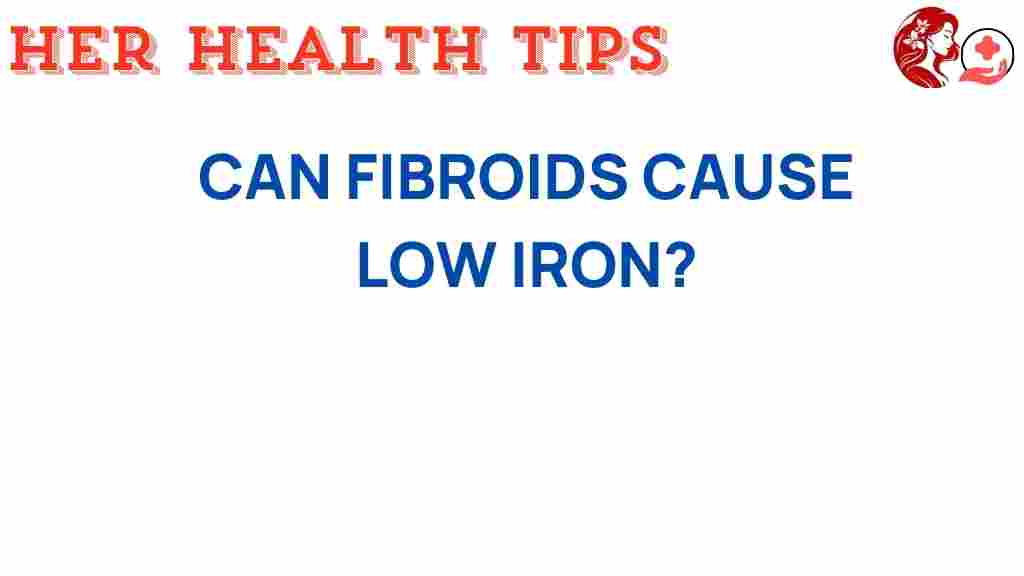Unraveling the Connection: Can Fibroids Cause Low Iron Levels?
In the realm of women’s health, understanding the intricate relationships between different medical conditions is crucial. One such relationship is between fibroids and low iron levels. Fibroids, also known as uterine leiomyomas, are non-cancerous growths in the uterus that can lead to various health issues, including anemia caused by low iron levels. This article delves deep into this connection, exploring symptoms, diagnosis, treatment options, and the overall health impact of this condition.
Understanding Fibroids
Fibroids are common, benign tumors that develop in the muscular wall of the uterus. They can vary in size, from tiny seeds to large masses, and may grow singly or in clusters. While many women with fibroids experience no symptoms, others may face significant health challenges. The prevalence of fibroids increases with age, particularly in women of reproductive age.
Symptoms of Fibroids
Recognizing the symptoms of fibroids is essential for timely diagnosis and treatment. Common symptoms include:
- Heavy Menstrual Bleeding: Excessive bleeding during periods is one of the most common symptoms.
- Pelvic Pain: This can range from mild discomfort to severe pain.
- Frequent Urination: Fibroids can press against the bladder, causing increased urgency to urinate.
- Back Pain: Some women experience pain in the lower back.
- Difficulty Emptying the Bladder: The presence of fibroids can interfere with normal bladder function.
The Link Between Fibroids and Low Iron Levels
The connection between fibroids and low iron levels primarily stems from the excess bleeding that fibroids can cause. Heavy menstrual bleeding, medically known as menorrhagia, can lead to significant blood loss, which in turn results in iron deficiency and anemia.
What is Anemia?
Anemia is a condition characterized by a deficiency of red blood cells or hemoglobin in the blood. It can lead to fatigue, weakness, and various other health issues. Low iron levels are a common cause of anemia, often termed iron deficiency anemia. Women are particularly at risk due to menstrual blood loss and other factors.
Symptoms of Low Iron Levels and Anemia
Identifying the symptoms of low iron levels and anemia is crucial for prompt treatment. Common symptoms include:
- Fatigue: Persistent tiredness is one of the most common signs.
- Pale Skin: A noticeable paleness of the skin can indicate low iron.
- Shortness of Breath: Difficulty breathing during physical activities may occur.
- Dizziness or Lightheadedness: These symptoms can often accompany anemia.
- Cold Hands and Feet: Poor circulation due to low iron levels can lead to feeling cold.
Diagnosis of Fibroids and Anemia
Diagnosing fibroids and associated low iron levels involves several steps:
- Medical History: A healthcare provider will take a detailed medical history, including menstrual patterns.
- Physical Examination: A pelvic exam may help detect fibroids.
- Imaging Tests: Ultrasound or MRI can be used to visualize fibroids in the uterus.
- Blood Tests: A complete blood count (CBC) will assess hemoglobin levels and confirm anemia.
Treatment Options for Fibroids and Low Iron
Treating fibroids and the resulting low iron levels involves a multi-faceted approach.
1. Managing Fibroids
Several options are available for treating fibroids:
- Medications: Hormonal therapies can help reduce symptoms by shrinking fibroids.
- Minimally Invasive Procedures: Techniques such as uterine artery embolization can reduce blood flow to fibroids.
- Surgery: In severe cases, surgical options such as myomectomy or hysterectomy may be necessary.
2. Addressing Low Iron Levels
To combat low iron levels and anemia, consider the following treatments:
- Iron Supplements: Taking oral iron supplements can help improve iron levels in the body.
- Dietary Changes: Incorporating iron-rich foods, such as red meat, beans, lentils, and leafy greens, can help boost iron intake.
- Vitamin C: Consuming vitamin C-rich foods alongside iron sources can enhance iron absorption.
Health Impact of Low Iron Levels
The health impact of low iron levels extends beyond fatigue and weakness. Chronic anemia can lead to more severe complications, including:
- Heart Problems: The heart has to work harder to pump oxygen-rich blood, potentially leading to heart failure.
- Pregnancy Complications: Low iron can increase risks during pregnancy, affecting both the mother and baby.
- Impaired Cognitive Function: Iron deficiency has been linked to difficulties in concentration and memory.
Troubleshooting Tips for Women with Fibroids and Low Iron
Managing fibroids and low iron levels can be challenging. Here are some troubleshooting tips:
- Regular Check-Ups: Schedule regular visits with your healthcare provider to monitor symptoms and iron levels.
- Track Symptoms: Keep a journal of your menstrual cycle and any symptoms you experience to share with your doctor.
- Educate Yourself: Understanding your condition can empower you to make informed decisions about treatment.
- Seek Support: Join support groups or online forums to connect with others facing similar challenges.
Conclusion
The connection between fibroids and low iron levels is a significant aspect of women’s health that cannot be overlooked. Understanding the symptoms, diagnosis, and treatment options available is crucial for managing both conditions effectively. If you suspect you have fibroids or are experiencing symptoms of low iron or anemia, it’s essential to consult with a healthcare professional for proper evaluation and personalized treatment plans.
For more information on women’s health, visit Women’s Health Foundation. If you’re looking for resources on managing anemia, check out Anemia Resources.
This article is in the category Conditions and created by HerHealthTips Team
